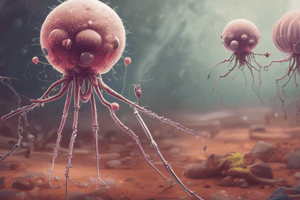Podcast
Questions and Answers
What pairs with adenine in DNA replication?
What pairs with adenine in DNA replication?
- Cytosine
- Uracil
- Thymine (correct)
- Guanine
What is the result of DNA replication?
What is the result of DNA replication?
- Two identical DNA molecules (correct)
- Four identical DNA molecules
- One identical DNA molecule
- Three identical DNA molecules
What is the purpose of DNA polymerase in DNA replication?
What is the purpose of DNA polymerase in DNA replication?
- To unwind the 2 strands of DNA
- To pull apart a molecule of DNA
- To join individual nucleotides to make new strands of DNA (correct)
- To break the hydrogen bonds between base pairs
What is the base sequence of the strand formed by a strand with a base sequence of ACGTAG?
What is the base sequence of the strand formed by a strand with a base sequence of ACGTAG?
What is the term for when a DNA strand comes apart?
What is the term for when a DNA strand comes apart?
What is the main mechanism by which bacteriophages infect bacterial cells?
What is the main mechanism by which bacteriophages infect bacterial cells?
What is the primary function of DNA?
What is the primary function of DNA?
What is the process of copying DNA prior to cell division called?
What is the process of copying DNA prior to cell division called?
What are the building blocks of nucleic acids?
What are the building blocks of nucleic acids?
What is the significance of Chargaff's rule?
What is the significance of Chargaff's rule?
What is the shape of the DNA molecule?
What is the shape of the DNA molecule?
What type of bonds hold the double helix together?
What type of bonds hold the double helix together?
What is the arrangement of the two strands of DNA?
What is the arrangement of the two strands of DNA?
Which nitrogenous bases bond together in DNA?
Which nitrogenous bases bond together in DNA?
Flashcards are hidden until you start studying
Study Notes
Transformation
- A process in which one strain of bacteria is changed by a gene or genes from another strain of bacteria.
Bacteriophage
- A kind of virus that infects bacteria.
- Infects bacterial cells, sticks to the surface, and injects its genetic information.
- The viral genes make many new bacteriophages, which destroy the bacterium.
DNA
- Stands for Deoxyribonucleic acid.
- Main jobs: store information, copying information, and transforming information.
- Made up of nucleotides, which are the building blocks of nucleic acids.
- Nucleotides are composed of three basic parts: a 5-carbon sugar called deoxyribose, a phosphate group, and a nitrogenous base.
Nucleotides
- There are 4 different types of nucleotides: Adenine, Guanine, Cytosine, and Thymine.
- These nitrogenous bases pair with each other in a specific manner: Adenine (A) pairs with Thymine (T) and Cytosine (C) pairs with Guanine (G).
Chargaff's Rule
- A rule that states the percentages of Adenine and Thymine bases are almost equal in any sample of DNA.
- The same is true for Guanine and Cytosine.
- Observed that A=T and G=C in DNA samples from diverse organisms.
Franklin's X-Rays
- Showed that the X-ray pictures of DNA strands are twisted around each other, forming a helix shape.
- Suggested that the nitrogenous bases are near the center of the DNA molecule.
Double Helix Structure
- Held together by hydrogen bonds, which are fairly weak bonds.
- The two strands of DNA run in opposite directions, forming an antiparallel arrangement.
Replication
- The process of copying DNA prior to cell division.
- Involves the unwinding of the double helix, and the formation of new strands.
- DNA polymerase is the main enzyme involved, joining individual nucleotides to make new strands of DNA.
Enzymes in DNA Replication
- Pull apart a molecule of DNA, breaking the hydrogen bonds between base pairs.
- Unwind the 2 strands.
- DNA polymerase produces the sugar-phosphate bonds that join nucleotides together to form the new strands.
Studying That Suits You
Use AI to generate personalized quizzes and flashcards to suit your learning preferences.




